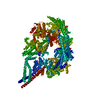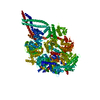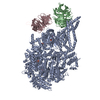[English] 日本語
 Yorodumi
Yorodumi- PDB-8fdu: Engineered human dynein motor domain in the microtubule-unbound s... -
+ Open data
Open data
- Basic information
Basic information
| Entry | Database: PDB / ID: 8fdu | ||||||||||||
|---|---|---|---|---|---|---|---|---|---|---|---|---|---|
| Title | Engineered human dynein motor domain in the microtubule-unbound state with LIS1 complex in the buffer containing ATP-Vi (local refined on AAA3-AAA5 and LIS1) | ||||||||||||
 Components Components |
| ||||||||||||
 Keywords Keywords |  MOTOR PROTEIN / MOTOR PROTEIN /  Dynein / Dynein /  motor domain / microtubule-unbound / motor domain / microtubule-unbound /  LIS1 LIS1 | ||||||||||||
| Function / homology |  Function and homology information Function and homology informationcorpus callosum morphogenesis / establishment of planar polarity of embryonic epithelium / microtubule cytoskeleton organization involved in establishment of planar polarity / ameboidal-type cell migration / interneuron migration /  1-alkyl-2-acetylglycerophosphocholine esterase complex / maintenance of centrosome location / microtubule sliding / selenocysteine biosynthetic process / platelet activating factor metabolic process ...corpus callosum morphogenesis / establishment of planar polarity of embryonic epithelium / microtubule cytoskeleton organization involved in establishment of planar polarity / ameboidal-type cell migration / interneuron migration / 1-alkyl-2-acetylglycerophosphocholine esterase complex / maintenance of centrosome location / microtubule sliding / selenocysteine biosynthetic process / platelet activating factor metabolic process ...corpus callosum morphogenesis / establishment of planar polarity of embryonic epithelium / microtubule cytoskeleton organization involved in establishment of planar polarity / ameboidal-type cell migration / interneuron migration /  1-alkyl-2-acetylglycerophosphocholine esterase complex / maintenance of centrosome location / microtubule sliding / selenocysteine biosynthetic process / platelet activating factor metabolic process / 1-alkyl-2-acetylglycerophosphocholine esterase complex / maintenance of centrosome location / microtubule sliding / selenocysteine biosynthetic process / platelet activating factor metabolic process /  acrosome assembly / radial glia-guided pyramidal neuron migration / microtubule organizing center organization / acrosome assembly / radial glia-guided pyramidal neuron migration / microtubule organizing center organization /  serine-tRNA ligase / serine-tRNA ligase /  serine-tRNA ligase activity / seryl-tRNA aminoacylation / cerebral cortex neuron differentiation / central region of growth cone / positive regulation of intracellular transport / positive regulation of embryonic development / reelin-mediated signaling pathway / regulation of metaphase plate congression / establishment of centrosome localization / positive regulation of cytokine-mediated signaling pathway / cortical microtubule organization / establishment of spindle localization / astral microtubule / positive regulation of spindle assembly / layer formation in cerebral cortex / nuclear membrane disassembly / auditory receptor cell development / positive regulation of dendritic spine morphogenesis / vesicle transport along microtubule / stem cell division / stereocilium / serine-tRNA ligase activity / seryl-tRNA aminoacylation / cerebral cortex neuron differentiation / central region of growth cone / positive regulation of intracellular transport / positive regulation of embryonic development / reelin-mediated signaling pathway / regulation of metaphase plate congression / establishment of centrosome localization / positive regulation of cytokine-mediated signaling pathway / cortical microtubule organization / establishment of spindle localization / astral microtubule / positive regulation of spindle assembly / layer formation in cerebral cortex / nuclear membrane disassembly / auditory receptor cell development / positive regulation of dendritic spine morphogenesis / vesicle transport along microtubule / stem cell division / stereocilium /  P-body assembly / myeloid leukocyte migration / P-body assembly / myeloid leukocyte migration /  dynein complex / COPI-independent Golgi-to-ER retrograde traffic / microtubule plus-end binding / minus-end-directed microtubule motor activity / dynein complex / COPI-independent Golgi-to-ER retrograde traffic / microtubule plus-end binding / minus-end-directed microtubule motor activity /  cytoplasmic dynein complex / negative regulation of JNK cascade / retrograde axonal transport / dynein light intermediate chain binding / brain morphogenesis / cytoplasmic dynein complex / negative regulation of JNK cascade / retrograde axonal transport / dynein light intermediate chain binding / brain morphogenesis /  motile cilium / nuclear migration / osteoclast development / microtubule associated complex / motile cilium / nuclear migration / osteoclast development / microtubule associated complex /  kinesin complex / dynein intermediate chain binding / dynein complex binding / cochlea development / transmission of nerve impulse / cell leading edge / germ cell development / kinesin complex / dynein intermediate chain binding / dynein complex binding / cochlea development / transmission of nerve impulse / cell leading edge / germ cell development /  dynactin binding / establishment of mitotic spindle orientation / dynactin binding / establishment of mitotic spindle orientation /  phospholipase binding / neuromuscular process controlling balance / neuroblast proliferation / phospholipase binding / neuromuscular process controlling balance / neuroblast proliferation /  protein secretion / positive regulation of axon extension / cytoplasmic microtubule / Amplification of signal from unattached kinetochores via a MAD2 inhibitory signal / microtubule-based process / COPI-mediated anterograde transport / lipid catabolic process / regulation of microtubule cytoskeleton organization / protein secretion / positive regulation of axon extension / cytoplasmic microtubule / Amplification of signal from unattached kinetochores via a MAD2 inhibitory signal / microtubule-based process / COPI-mediated anterograde transport / lipid catabolic process / regulation of microtubule cytoskeleton organization /  stress granule assembly / cytoplasmic microtubule organization / Mitotic Prometaphase / regulation of mitotic spindle organization / EML4 and NUDC in mitotic spindle formation / axon cytoplasm / JNK cascade / Loss of Nlp from mitotic centrosomes / Loss of proteins required for interphase microtubule organization from the centrosome / Recruitment of mitotic centrosome proteins and complexes / Resolution of Sister Chromatid Cohesion / Recruitment of NuMA to mitotic centrosomes / HSP90 chaperone cycle for steroid hormone receptors (SHR) in the presence of ligand / Anchoring of the basal body to the plasma membrane / MHC class II antigen presentation / positive regulation of mitotic cell cycle / adult locomotory behavior / AURKA Activation by TPX2 / mitotic spindle organization / stress granule assembly / cytoplasmic microtubule organization / Mitotic Prometaphase / regulation of mitotic spindle organization / EML4 and NUDC in mitotic spindle formation / axon cytoplasm / JNK cascade / Loss of Nlp from mitotic centrosomes / Loss of proteins required for interphase microtubule organization from the centrosome / Recruitment of mitotic centrosome proteins and complexes / Resolution of Sister Chromatid Cohesion / Recruitment of NuMA to mitotic centrosomes / HSP90 chaperone cycle for steroid hormone receptors (SHR) in the presence of ligand / Anchoring of the basal body to the plasma membrane / MHC class II antigen presentation / positive regulation of mitotic cell cycle / adult locomotory behavior / AURKA Activation by TPX2 / mitotic spindle organization /  filopodium / RHO GTPases Activate Formins / hippocampus development / filopodium / RHO GTPases Activate Formins / hippocampus development /  phosphoprotein binding / phosphoprotein binding /  neuron migration / modulation of chemical synaptic transmission / Schaffer collateral - CA1 synapse / cerebral cortex development / microtubule cytoskeleton organization / neuron migration / modulation of chemical synaptic transmission / Schaffer collateral - CA1 synapse / cerebral cortex development / microtubule cytoskeleton organization /  kinetochore / Aggrephagy kinetochore / AggrephagySimilarity search - Function | ||||||||||||
| Biological species |   Homo sapiens (human) Homo sapiens (human)   Thermus thermophilus (bacteria) Thermus thermophilus (bacteria) | ||||||||||||
| Method |  ELECTRON MICROSCOPY / ELECTRON MICROSCOPY /  single particle reconstruction / single particle reconstruction /  cryo EM / Resolution: 3.3 Å cryo EM / Resolution: 3.3 Å | ||||||||||||
 Authors Authors | Ton, W. / Wang, Y. / Chai, P. | ||||||||||||
| Funding support |  United States, 3items United States, 3items
| ||||||||||||
 Citation Citation |  Journal: Nat Struct Mol Biol / Year: 2023 Journal: Nat Struct Mol Biol / Year: 2023Title: Microtubule-binding-induced allostery triggers LIS1 dissociation from dynein prior to cargo transport. Authors: William D Ton / Yue Wang / Pengxin Chai / Cisloynny Beauchamp-Perez / Nicholas T Flint / Lindsay G Lammers / Hao Xiong / Kai Zhang / Steven M Markus /  Abstract: The lissencephaly-related protein LIS1 is a critical regulator of cytoplasmic dynein that governs motor function and intracellular localization (for example, to microtubule plus-ends). Although LIS1 ...The lissencephaly-related protein LIS1 is a critical regulator of cytoplasmic dynein that governs motor function and intracellular localization (for example, to microtubule plus-ends). Although LIS1 binding is required for dynein activity, its unbinding prior to initiation of cargo transport is equally important, since preventing dissociation leads to dynein dysfunction. To understand whether and how dynein-LIS1 binding is modulated, we engineered dynein mutants locked in a microtubule-bound (MT-B) or microtubule-unbound (MT-U) state. Whereas the MT-B mutant exhibits low LIS1 affinity, the MT-U mutant binds LIS1 with high affinity, and as a consequence remains almost irreversibly associated with microtubule plus-ends. We find that a monomeric motor domain is sufficient to exhibit these opposing LIS1 affinities, and that this is evolutionarily conserved between yeast and humans. Three cryo-EM structures of human dynein with and without LIS1 reveal microtubule-binding induced conformational changes responsible for this regulation. Our work reveals key biochemical and structural insight into LIS1-mediated dynein activation. | ||||||||||||
| History |
|
- Structure visualization
Structure visualization
| Structure viewer | Molecule:  Molmil Molmil Jmol/JSmol Jmol/JSmol |
|---|
- Downloads & links
Downloads & links
- Download
Download
| PDBx/mmCIF format |  8fdu.cif.gz 8fdu.cif.gz | 349.8 KB | Display |  PDBx/mmCIF format PDBx/mmCIF format |
|---|---|---|---|---|
| PDB format |  pdb8fdu.ent.gz pdb8fdu.ent.gz | 252 KB | Display |  PDB format PDB format |
| PDBx/mmJSON format |  8fdu.json.gz 8fdu.json.gz | Tree view |  PDBx/mmJSON format PDBx/mmJSON format | |
| Others |  Other downloads Other downloads |
-Validation report
| Arichive directory |  https://data.pdbj.org/pub/pdb/validation_reports/fd/8fdu https://data.pdbj.org/pub/pdb/validation_reports/fd/8fdu ftp://data.pdbj.org/pub/pdb/validation_reports/fd/8fdu ftp://data.pdbj.org/pub/pdb/validation_reports/fd/8fdu | HTTPS FTP |
|---|
-Related structure data
| Related structure data |  29014MC  8fcyC  8fd6C  8fdtC C: citing same article ( M: map data used to model this data |
|---|---|
| Similar structure data | Similarity search - Function & homology  F&H Search F&H Search |
- Links
Links
- Assembly
Assembly
| Deposited unit | 
|
|---|---|
| 1 |
|
- Components
Components
| #1: Protein | Mass: 357459.125 Da / Num. of mol.: 1 Source method: isolated from a genetically manipulated source Details: residues 1458-3277 of dynein followed by residues 30-96 of serine-tRNA ligase, followed by residues 3412-4646 of dynein Source: (gene. exp.)   Homo sapiens (human), (gene. exp.) Homo sapiens (human), (gene. exp.)    Thermus thermophilus (bacteria) Thermus thermophilus (bacteria)Gene: DYNC1H1, DHC1, DNCH1, DNCL, DNECL, DYHC, KIAA0325, serS, TTHA0875 Strain: HB8 / Production host:   Spodoptera frugiperda (fall armyworm) Spodoptera frugiperda (fall armyworm)References: UniProt: Q14204, UniProt: Q5SJX7,  serine-tRNA ligase serine-tRNA ligase | ||||
|---|---|---|---|---|---|
| #2: Protein | Mass: 66423.547 Da / Num. of mol.: 2 Source method: isolated from a genetically manipulated source Details: SNAP tag present on C-terminus,SNAP tag present on C-terminus Source: (gene. exp.)   Homo sapiens (human) / Gene: PAFAH1B1, LIS1, MDCR, MDS, PAFAHA / Production host: Homo sapiens (human) / Gene: PAFAH1B1, LIS1, MDCR, MDS, PAFAHA / Production host:   Spodoptera frugiperda (fall armyworm) / References: UniProt: P43034 Spodoptera frugiperda (fall armyworm) / References: UniProt: P43034#3: Chemical |  Adenosine diphosphate Adenosine diphosphateHas ligand of interest | Y | |
-Experimental details
-Experiment
| Experiment | Method:  ELECTRON MICROSCOPY ELECTRON MICROSCOPY |
|---|---|
| EM experiment | Aggregation state: PARTICLE / 3D reconstruction method:  single particle reconstruction single particle reconstruction |
- Sample preparation
Sample preparation
| Component | Name: Engineered human dynein motor domain in microtubule-unbound state with LIS1 complex in the buffer containing ATP-Vi Type: COMPLEX / Entity ID: #1-#2 / Source: RECOMBINANT |
|---|---|
| Molecular weight | Value: 0.49 MDa / Experimental value: YES |
| Source (natural) | Organism:   Homo sapiens (human) Homo sapiens (human) |
| Source (recombinant) | Organism:   Spodoptera frugiperda (fall armyworm) Spodoptera frugiperda (fall armyworm) |
| Buffer solution | pH: 7.4 Details: 50 mM Tris pH 7.4, 150 mM potassium acetate, 2 mM magnesium acetate, 1 mM EGTA, 1 mM DTT, and 0.1 mM Mg-ATP |
| Specimen | Conc.: 0.5 mg/ml / Embedding applied: NO / Shadowing applied: NO / Staining applied : NO / Vitrification applied : NO / Vitrification applied : YES : YES |
| Specimen support | Grid material: COPPER / Grid mesh size: 300 divisions/in. / Grid type: Quantifoil R2/1 |
Vitrification | Instrument: FEI VITROBOT MARK IV / Cryogen name: ETHANE / Humidity: 95 % / Chamber temperature: 277 K |
- Electron microscopy imaging
Electron microscopy imaging
| Experimental equipment |  Model: Titan Krios / Image courtesy: FEI Company |
|---|---|
| Microscopy | Model: FEI TITAN KRIOS |
| Electron gun | Electron source : :  FIELD EMISSION GUN / Accelerating voltage: 300 kV / Illumination mode: FLOOD BEAM FIELD EMISSION GUN / Accelerating voltage: 300 kV / Illumination mode: FLOOD BEAM |
| Electron lens | Mode: BRIGHT FIELD Bright-field microscopy / Nominal magnification: 105000 X / Calibrated magnification: 105000 X / Nominal defocus max: 3000 nm / Nominal defocus min: 1200 nm / Calibrated defocus min: 1200 nm / Calibrated defocus max: 3000 nm / Cs Bright-field microscopy / Nominal magnification: 105000 X / Calibrated magnification: 105000 X / Nominal defocus max: 3000 nm / Nominal defocus min: 1200 nm / Calibrated defocus min: 1200 nm / Calibrated defocus max: 3000 nm / Cs : 2.7 mm / C2 aperture diameter: 100 µm : 2.7 mm / C2 aperture diameter: 100 µm |
| Specimen holder | Cryogen: NITROGEN / Specimen holder model: FEI TITAN KRIOS AUTOGRID HOLDER |
| Image recording | Electron dose: 40 e/Å2 / Detector mode: SUPER-RESOLUTION / Film or detector model: GATAN K3 (6k x 4k) |
- Processing
Processing
| Software | Name: UCSF ChimeraX / Version: 1.4/v9 / Classification: model building / URL: https://www.rbvi.ucsf.edu/chimerax/ / Os: macOS / Type: package | ||||||||||||||||||||||||||||||||||||
|---|---|---|---|---|---|---|---|---|---|---|---|---|---|---|---|---|---|---|---|---|---|---|---|---|---|---|---|---|---|---|---|---|---|---|---|---|---|
| EM software |
| ||||||||||||||||||||||||||||||||||||
CTF correction | Type: PHASE FLIPPING AND AMPLITUDE CORRECTION | ||||||||||||||||||||||||||||||||||||
3D reconstruction | Resolution: 3.3 Å / Resolution method: FSC 0.143 CUT-OFF / Num. of particles: 53572 / Algorithm: BACK PROJECTION / Symmetry type: POINT | ||||||||||||||||||||||||||||||||||||
| Atomic model building | Protocol: RIGID BODY FIT / Space: REAL |
 Movie
Movie Controller
Controller





 PDBj
PDBj





















